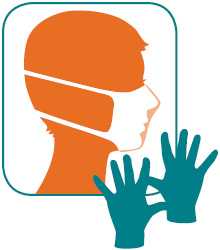

If the person you are visiting is on transmission-based precautions (e.g., contact, droplet, or airborne isolation), talk to the nurse before entering the room to find out what steps you will have to take—such as, wearing a mask, a gown, and/or gloves.
In many different healthcare settings, transmission-based precautions are used to help stop the spread of germs from one person to another. The goal is to protect patients, their families, other visitors, and healthcare workers—and stop germs from spreading across a healthcare setting.
There are three different types of transmission precautions:
If you or a family member has been placed on transmission precautions, there will be a sign at the door of your hospital room to remind visitors and healthcare workers which precautions are needed. It is important to understand what this means for you and what you should expect from the hospital staff.
All visitors and healthcare workers should follow the isolation precautions. In some cases, this means visitors (and visits) may have to be limited. Visitors should not eat or drink in these rooms and should always clean their hands before entering the room and upon exiting the room.